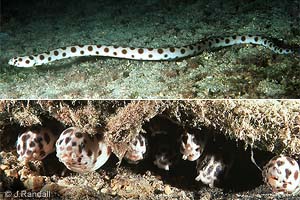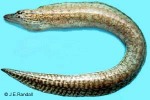Cook Islands Natural Heritage Articles
Are there snakes in the Cook Islands?
Inshore sea-snakes are common on and around the reefs of Fiji, Samoa, Tonga and Niue, but have never been recorded in the Cook Islands. The snake-like creatures in our lagoons are scaleless fish in the Snake-eel Family.
Snake-eels differ externally from sea-snakes in having a dorsal fin along most of the body, a more-or-less pointed tail, and protruding nostrils on the upper lip. Although they are not poisonous, they do have lots of small sharp teeth.
 The most common snake-eels are the Spotted Snake-eel (Myrichthys maculosus) and the Barred Snake-eel (Myrichthys colubrinus). The Spotted Snake-eel is up to 80cm, cream in colour with black spots. The Barred Snake-eel is a similar length with dark bands completely encircling its white body. And a less common third species has its bands reduced to dark saddles.
The most common snake-eels are the Spotted Snake-eel (Myrichthys maculosus) and the Barred Snake-eel (Myrichthys colubrinus). The Spotted Snake-eel is up to 80cm, cream in colour with black spots. The Barred Snake-eel is a similar length with dark bands completely encircling its white body. And a less common third species has its bands reduced to dark saddles.
 Although we have no inshore sea-snakes, we share with the rest of the tropical Pacific, the oceanic Yellow-bellied Sea-snake (Pelamis platurus). Like the inshore sea-snakes, the Yellow-bellied Sea-snake has external scales, a vertical paddle-like tail, no dorsal fin, and non-protruding nostrils. They swim to the surface to fill their lungs with air and can remain submerged for about two hours.
Although we have no inshore sea-snakes, we share with the rest of the tropical Pacific, the oceanic Yellow-bellied Sea-snake (Pelamis platurus). Like the inshore sea-snakes, the Yellow-bellied Sea-snake has external scales, a vertical paddle-like tail, no dorsal fin, and non-protruding nostrils. They swim to the surface to fill their lungs with air and can remain submerged for about two hours.
The Yellow-bellied Sea-snake grows to about a metre in length. Although its colour is variable, it typically has a black upperside separated by a sharp line of demarcation from a yellowish belly. The paddle-like tail is usually mottled black and yellow.
Unlike the inshore sea-snakes which live around the reefs, the Yellow-bellied Sea-snake lives its entire life in the surface waters of the open ocean. They even give birth to free-swimming young as they float along, grabbing small fish here and there.
Despite their preference for the open ocean, Yellow-bellied Sea-snakes are sometimes stranded on islands. For example, in July 1981 Sharon Mackey found one stranded on a beach in Aitutaki, which she killed by freezing. And since then, three more have been found stranded but alive on beaches in Aitutaki - 1985, 1990 and 1992. There have been no recorded strandings on any other island in the Cook Islands during the same time period.
Sea-snakes are very poisonous, each having enough venom to kill three people. Fortunately, Yellow-bellied Sea-snakes are non-aggressive, and if provoked they can only bite small objects, such as your finger; and even then, they withhold most of their poison. Nevertheless, if you are unlucky enough to notice two small painless puncture wounds get medical help immediately.
First published Cook Islands News 1993
Illustration: Judith Kunzlé
About Gerald McCormack
 Gerald McCormack has worked for the Cook Islands Government since 1980. In 1990 he became the director and researcher for the Cook Islands Natural Heritage Project - a Trust since 1999.
He is the lead developer of the Biodiversity Database, which is based on information from local and overseas experts, fieldwork and library research. He is an accomplished photographer.
Gerald McCormack has worked for the Cook Islands Government since 1980. In 1990 he became the director and researcher for the Cook Islands Natural Heritage Project - a Trust since 1999.
He is the lead developer of the Biodiversity Database, which is based on information from local and overseas experts, fieldwork and library research. He is an accomplished photographer.
Citation Information
McCormack, Gerald (2005) Are there snakes in the Cook Islands?. Cook Islands Natural Heritage Trust, Rarotonga. Online at http://cookislands.bishopmuseum.org. ![]()
Please refer to our use policy
